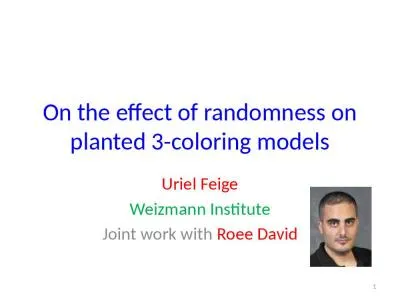PPT-Strong list coloring, Group connectivity and the Polynomial
Author : kittie-lecroy | Published Date : 2018-01-17
Michael Tarsi Blavatnik School of Computer Science TelAviv University Israel The Polynomial Method Alon T The Graphic case P G x i x j over all edges ij E A proper
Presentation Embed Code
Download Presentation
Download Presentation The PPT/PDF document "Strong list coloring, Group connectivity..." is the property of its rightful owner. Permission is granted to download and print the materials on this website for personal, non-commercial use only, and to display it on your personal computer provided you do not modify the materials and that you retain all copyright notices contained in the materials. By downloading content from our website, you accept the terms of this agreement.
Strong list coloring, Group connectivity and the Polynomial: Transcript
Download Rules Of Document
"Strong list coloring, Group connectivity and the Polynomial"The content belongs to its owner. You may download and print it for personal use, without modification, and keep all copyright notices. By downloading, you agree to these terms.
Related Documents



![[EPUB] - 123 things BIG & JUMBO Coloring Book: 123 Coloring Pages!!, Easy, LARGE, GIANT](https://thumbs.docslides.com/901156/epub-123-things-big-jumbo-coloring-book-123-coloring-pages-easy-large-giant-simple-picture-coloring-books-for-toddlers.jpg)
![[DOWLOAD]-Bible Coloring Book For Adults Gods Blessings for You, Bible Verse Coloring](https://thumbs.docslides.com/969927/dowload-bible-coloring-book-for-adults-gods-blessings-for-you-bible-verse-coloring-book-for-women-scripture-coloring-book-for-teens.jpg)
![[READING BOOK]-Unicorn Coloring Book Vol. 1 Unicorn Coloring Book for Kids. (Dover Coloring](https://thumbs.docslides.com/969977/reading-book-unicorn-coloring-book-vol-1-unicorn-coloring-book-for-kids-dover-coloring-books.jpg)
![[BEST]-Unicorn Coloring Book Vol. 2 Unicorn Coloring Books For Kids. (Dover Coloring](https://thumbs.docslides.com/969978/best-unicorn-coloring-book-vol-2-unicorn-coloring-books-for-kids-dover-coloring-books.jpg)
![[eBOOK]-Bible Coloring Book For Adults: Gods Blessings for You, Bible Verse Coloring Book](https://thumbs.docslides.com/974239/ebook-bible-coloring-book-for-adults-gods-blessings-for-you-bible-verse-coloring-book-for-women-scripture-coloring-book-for-teens.jpg)
![[PDF]-Unicorn : Coloring Book Vol. 2: Unicorn Coloring Books For Kids. (Dover Coloring](https://thumbs.docslides.com/974428/pdf-unicorn-coloring-book-vol-2-unicorn-coloring-books-for-kids-dover-coloring-books.jpg)
![[eBOOK]-Motivational Quotes Coloring Book: Inspirational Quotes Coloring Book | Coloring](https://thumbs.docslides.com/988811/ebook-motivational-quotes-coloring-book-inspirational-quotes-coloring-book-coloring-book-for-adults-and-teens-with-quotes-motivational-quotes-for-good-vibes-positive-affirmations-stress-relief.jpg)
![[READ] Human Anatomy Coloring Book: an Entertaining and Instructive Guide to the Human](https://thumbs.docslides.com/1005807/read-human-anatomy-coloring-book-an-entertaining-and-instructive-guide-to-the-human-body-bones-muscles-blood-nerves-and-how-they-work-coloring-books-dover-science-for-kids-coloring-books.jpg)
![[EBOOK] ABC Coloring Book: Color 100+ Animals, Birds, Vehicles, Fruits, Toys Alphabets](https://thumbs.docslides.com/1007810/ebook-abc-coloring-book-color-100-animals-birds-vehicles-fruits-toys-alphabets-for-boys-girls-coloring-book-for-toddlers-and-preschool-kids-book-and-coloring-pages-kids-ages-3-5.jpg)
![[READ] Toddler Coloring Book: Numbers, Letters, Shapes and Animals, Coloring Book for](https://thumbs.docslides.com/1007811/read-toddler-coloring-book-numbers-letters-shapes-and-animals-coloring-book-for-kids-age-1-3-preschool-coloring-book.jpg)
![[EBOOK] 100 Things For Toddler Coloring Book: Easy and Big Coloring Books for Toddlers:](https://thumbs.docslides.com/1008433/ebook-100-things-for-toddler-coloring-book-easy-and-big-coloring-books-for-toddlers-kids-ages-2-4-4-8-boys-girls-fun-early-learning-coloring-book-for-kids.jpg)
